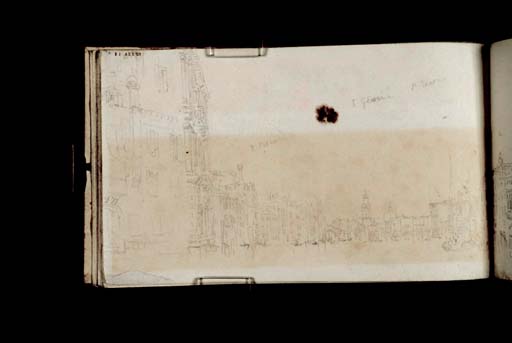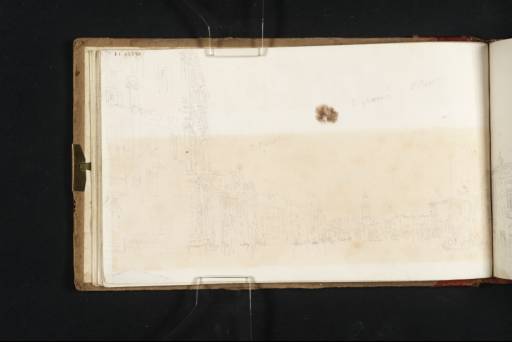Joseph Mallord William Turner Palaces on the Grand Canal, Venice, from the Junction with the Rio di Ca' Foscari, with the Rialto Bridge in the Distance 1819
Image 1 of 2
-
 Joseph Mallord William Turner, Palaces on the Grand Canal, Venice, from the Junction with the Rio di Ca' Foscari, with the Rialto Bridge in the Distance 1819
Joseph Mallord William Turner, Palaces on the Grand Canal, Venice, from the Junction with the Rio di Ca' Foscari, with the Rialto Bridge in the Distance 1819 -
 Joseph Mallord William Turner, Palaces on the Grand Canal, Venice, from the Junction with the Rio di Ca' Foscari, with the Rialto Bridge in the Distance 1819 (Enhanced image)Enhanced image
Joseph Mallord William Turner, Palaces on the Grand Canal, Venice, from the Junction with the Rio di Ca' Foscari, with the Rialto Bridge in the Distance 1819 (Enhanced image)Enhanced image
Joseph Mallord William Turner,
Palaces on the Grand Canal, Venice, from the Junction with the Rio di Ca' Foscari, with the Rialto Bridge in the Distance
1819
Joseph Mallord William Turner 1775–1851
Folio 72 Recto:
Palaces on the Grand Canal, Venice, from the Junction with the Rio di Ca’ Foscari, with the Rialto Bridge in the Distance 1819
D14453
Turner Bequest CLXXV 72
Turner Bequest CLXXV 72
Pencil on white wove paper, 112 x 185 mm
Inscribed by Turner in pencil ‘P Pisani’ left of centre, and ‘S [?Geovani]’ and ‘St Jacomo’ towards top right
Inscribed by John Ruskin in blue ink ‘72’ bottom left, upside down and ‘300’ top left, upside down
Stamped in black ‘CLXXV 72’ top left, upside down
Inscribed by Turner in pencil ‘P Pisani’ left of centre, and ‘S [?Geovani]’ and ‘St Jacomo’ towards top right
Inscribed by John Ruskin in blue ink ‘72’ bottom left, upside down and ‘300’ top left, upside down
Stamped in black ‘CLXXV 72’ top left, upside down
Accepted by the nation as part of the Turner Bequest 1856
Exhibition history
1904
National Gallery, London, various dates to at least 1904 (602f, as ‘The Grand Canal. From Casa Foscari to the Rialto’, one of ‘Twelve Leaves from a Book of Sketches at Venice’).
References
1904
E.T. Cook and Alexander Wedderburn eds., Library Edition: The Works of John Ruskin: Volume XIII: Turner: The Harbours of England; Catalogues and Notes, London 1904, pp.304 no.258, as ‘The Grand Canal. From Casa Foscari to the Rialto’, 636 no.602, as one of ‘Twelve Leaves from a Book of Sketches at Venice’.
1909
A.J. Finberg, A Complete Inventory of the Drawings of the Turner Bequest, London 1909, vol.I, p.515, CLXXV 72, as ‘Continuation of previous drawing. [i.e. “The Grand Canal; with Palazzo Foscari, Giustiniani, Rezzonico, &c., on the right”] Exhibited drawings, No.602e [sic; see main catalogue entry], N.G.’.
1930
A.J. Finberg, In Venice with Turner, London 1930, pp.45, 54, 166, as ‘From the Foscari palace, looking towards the Rialto. On the water below the Charmet palace; “In the light – v. green.”’, pl.VII, as ‘Looking towards the Rialto from the Foscari Palace’.
1980
Keith Andrews, The Vaughan Bequest of Turner Watercolours, Edinburgh 1980, p.32.
1985
Lindsay Stainton, Turner’s Venice, London 1985, p.56 under no.55.
Inverted relative to the sketchbook’s foliation, the drawing continues across folio 71 verso opposite (D14452), from a viewpoint at the entrance to the Rio di Ca’ Foscari, looking east across the bend of the Grand Canal at this point. On the present page the view is continued east-north-east in the direction of the Rialto Bridge, the southern half of which is just visible below the adjacent campanile of San Bartolomeo, itself bracketed by the pinnacles and dome of Santi Giovanni e Paolo, about half as far again beyond the bridge. With the distinctive twin obelisk finials of the Palazzo Papadopoli above the bridge in the distance, the Palazzo Balbi looms in the left foreground.1
Finberg related the overall view to a painting of about 1735 by Canaletto (1697–1768) of Venice: A Regatta on the Grand Canal (National Gallery, London), from a higher viewpoint (likely the Ca’ Foscari), noting minor changes to the buildings between Canaletto’s, Turner’s and his own times.2 He also noted Turner’s ‘P Pisani’ as indicating the Palazzo Pisani Moretta, which contained a Veronese painting Turner had been asked to ‘observe particularly’, as discussed by Nicola Moorby in entries for the contemporary Route to Rome sketchbook (Tate D13904–D13905; Turner Bequest CLXXI 24a–25),3 and that the chance, distance glimpse of Santi Giovanni e Paolo here is Turner’s only exterior record of the imposing church he visited to see Titian’s St Peter Martyr altarpiece, as discussed under folio 40 verso (D14390).4
Keith Andrews5 and Lindsay Stainton6 have compared the view in the 1840 watercolour Palazzo Balbi on the Grand Canal (National Galleries of Scotland).7 Stainton has also noted the present drawing in relation to another 1840 watercolour, from the Grand Canal and Giudecca sketchbook (Tate D32136; Turner Bequest CCCXV 20).8 For other drawings made in the vicinity and an overview of Turner’s coverage of Venice, see the sketchbook’s Introduction.
In his 1909 Inventory, Finberg listed this page as having been ‘Exhibited drawings, No.602e, N.G.’ in the early National Gallery sequence, which he amended in his interleaved copy, crossing out the ‘e’ and inserting ‘f’.9 As the published topographical titles make clear, 602e was actually folio 61 recto (D14431). Evidently confused, the Turner scholar C.F. Bell annotated another copy: ‘?No View looking up the Grand Canal towards the Rialto’.10 For an attempt to clarify the difficulties arising out of the extraction of twelve leaves for display and their subsequent restoration to the sketchbook, see the technical notes in the Introduction.
Technical notes:
An irregular loss to the bottom left corner has been made good with similar white wove paper. The dark band across the lower two thirds of the page indicates severe light damage resulting from prolonged early display, when the mount was proportioned to focus attention on the view along the canal.
Finberg annotated his 1909 Inventory entry, noting this page as ‘stained by flood | 13/8/29’,1 upon inspection after the Tate Gallery flood of January 1928. This presumably accounts for the monochrome collotype plate in his 1930 book, derived from a pre-flood photograph,2 not showing the dark blot now evident in the blank area above the centre. Alternatively, the plate could have been retouched to exclude existing damage as part of the general cosmetic process of enhancing the contrast of Turner’s pencil work (to the extent that it could be taken as charcoal), which also minimised signs of light exposure.
Matthew Imms
March 2017
MS note by Finberg in interleaved copy of Finberg 1909, Tate Britain Prints and Drawings Room, I, p.515.
How to cite
Matthew Imms, ‘Palaces on the Grand Canal, Venice, from the Junction with the Rio di Ca’ Foscari, with the Rialto Bridge in the Distance 1819 by Joseph Mallord William Turner’, catalogue entry, March 2017, in David Blayney Brown (ed.), J.M.W. Turner: Sketchbooks, Drawings and Watercolours, Tate Research Publication, July 2017, https://www

